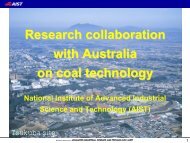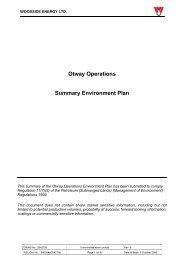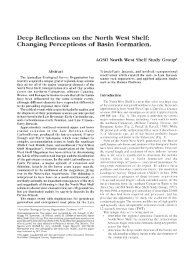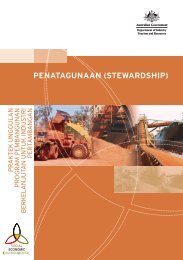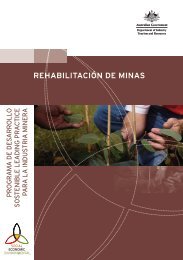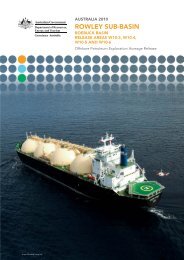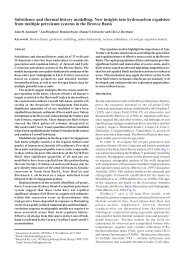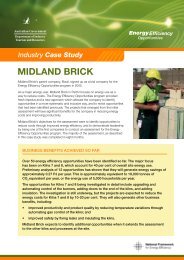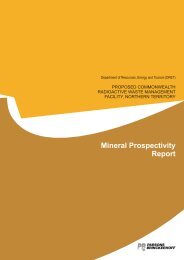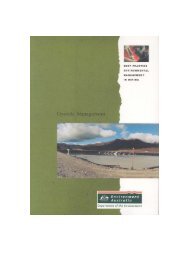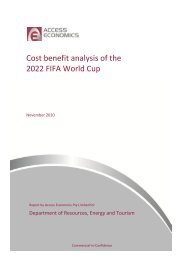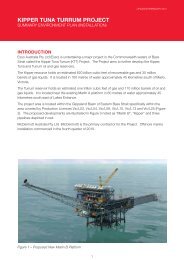A guide to leading practice sustainable development in mining
A guide to leading practice sustainable development in mining
A guide to leading practice sustainable development in mining
You also want an ePaper? Increase the reach of your titles
YUMPU automatically turns print PDFs into web optimized ePapers that Google loves.
But are noise levels <strong>in</strong>creas<strong>in</strong>g? The EPA Vic<strong>to</strong>ria (EPA, 2007) <strong>in</strong>dicates that noise<br />
across Melbourne hasn’t <strong>in</strong>creased s<strong>in</strong>ce the 1970s and yet community compla<strong>in</strong>ts<br />
have risen considerably. In Brita<strong>in</strong>, noise compla<strong>in</strong>ts are five times higher than they<br />
were 20 years ago. It is clear therefore that the community is becom<strong>in</strong>g less <strong>to</strong>lerant<br />
<strong>to</strong> noise than it once was.<br />
The issue of dust emanat<strong>in</strong>g from a m<strong>in</strong>e site has been the focus of <strong>in</strong>tense media<br />
scrut<strong>in</strong>y <strong>in</strong> Western Australia recently. The issue surrounds the export of lead<br />
concentrate from Magellan Metals’ Wiluna m<strong>in</strong>e from the ports of Esperance and<br />
Fremantle. The extent of community dissatisfaction can be seen from newspaper<br />
headl<strong>in</strong>es <strong>in</strong> November 2008 (Clarke, 2008) – “Unions promise <strong>to</strong> fight Barnett<br />
over lead shipments” and “Port’s mayor vows <strong>to</strong> fight risky lead exports” and “Lead<br />
leaches hope of Esperance future”.<br />
These issues are important <strong>in</strong> all sec<strong>to</strong>rs of our <strong>in</strong>dustry – coal, metalliferous and the<br />
quarry sec<strong>to</strong>r. Indeed, the front cover of “Quarry”, the official Journal of the Institute<br />
of Quarry<strong>in</strong>g Australia <strong>in</strong> November 2007 headl<strong>in</strong>ed “Ensur<strong>in</strong>g your neighbours don’t<br />
eat dust”. The issues are important whether the m<strong>in</strong>e is situated <strong>in</strong> the Tanami Desert,<br />
the Hunter Valley or a more densely populated area. It is often <strong>in</strong> the latter situation<br />
where most problems arise. In Australia, these situations are typical of quarries for<br />
construction materials; m<strong>in</strong>es with a residential workforce such as Kalgoorlie, Mt Isa<br />
or Broken Hill or m<strong>in</strong><strong>in</strong>g fields <strong>in</strong> locations such as the Hunter Valley where m<strong>in</strong><strong>in</strong>g is<br />
often not considered the most desirable land use. Of course many Australian m<strong>in</strong><strong>in</strong>g<br />
companies operate <strong>in</strong>ternationally and it is <strong>in</strong> these countries, where far higher<br />
densities of populations exist <strong>in</strong> the vic<strong>in</strong>ity of the m<strong>in</strong>es, that the community impacts<br />
of airborne particulates, noise and vibration are exacerbated.<br />
The issue of air blast overpressure has <strong>to</strong> be well managed if m<strong>in</strong>es are <strong>in</strong> close<br />
proximity <strong>to</strong> residential areas. Blast overpressure levels experienced from<br />
operations on open cut m<strong>in</strong>es depend on many fac<strong>to</strong>rs <strong>in</strong>clud<strong>in</strong>g the design of the<br />
blast, the distance from the blast <strong>to</strong> the receiver and the prevail<strong>in</strong>g atmospheric<br />
conditions. The way <strong>in</strong> which temperature and w<strong>in</strong>d vary along the path through<br />
which the over pressure wave travels from the source <strong>to</strong> the receiver is particularly<br />
important <strong>in</strong> determ<strong>in</strong><strong>in</strong>g the overpressure experienced at the receiver. Modell<strong>in</strong>g<br />
allows the effects of atmospheric conditions <strong>to</strong> be taken <strong>in</strong><strong>to</strong> account before<br />
mak<strong>in</strong>g the decision <strong>to</strong> blast and ultimately used <strong>to</strong> predict the enhancement of<br />
blast overpressure levels. The results are presented as con<strong>to</strong>ur plots overlaid on<br />
a map of the area surround<strong>in</strong>g the blast. An example show<strong>in</strong>g blast overpressure<br />
enhancement is provided <strong>in</strong> the figure below. The results are promis<strong>in</strong>g and the<br />
system appears <strong>to</strong> be a useful <strong>to</strong>ol, <strong>in</strong> its current state of <strong>development</strong>, <strong>to</strong> improve<br />
the management of impacts from blast<strong>in</strong>g (see LP ANCV p.52).<br />
A GUIDE TO LEADING PRACTICE SUSTAINABLE DEVELOPMENT IN MINING 89



